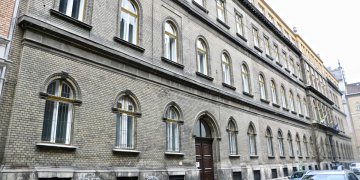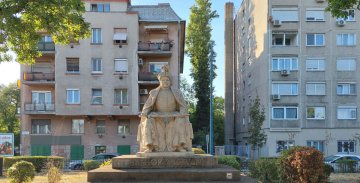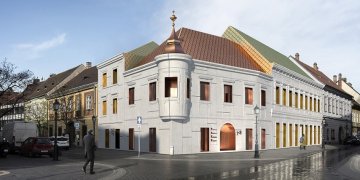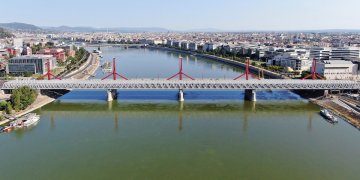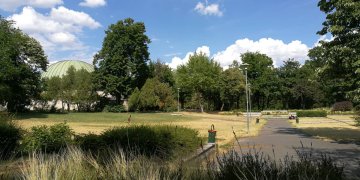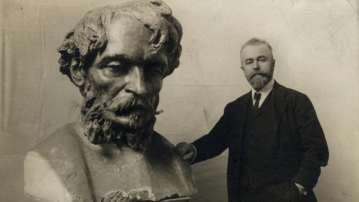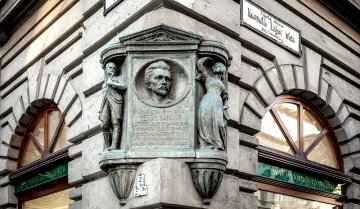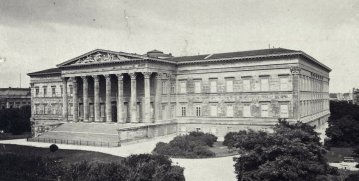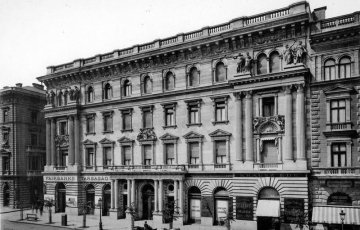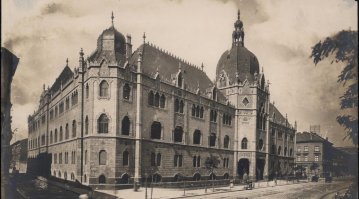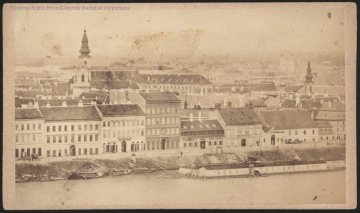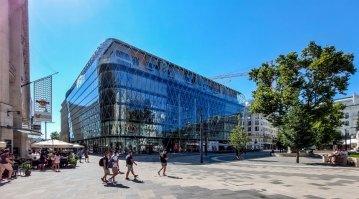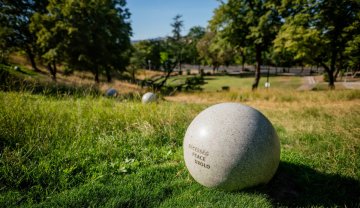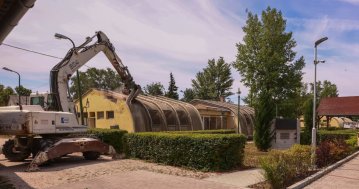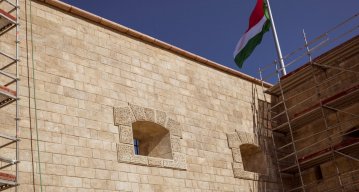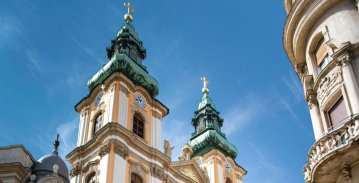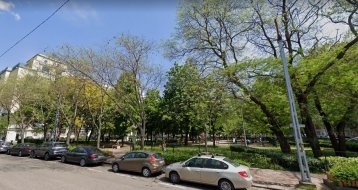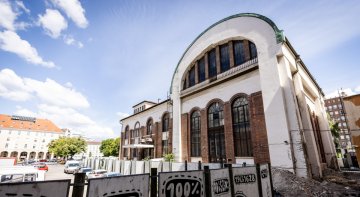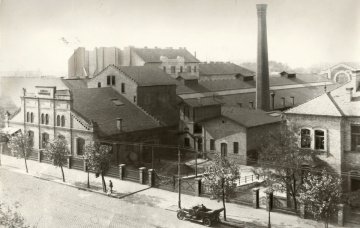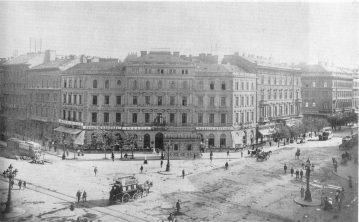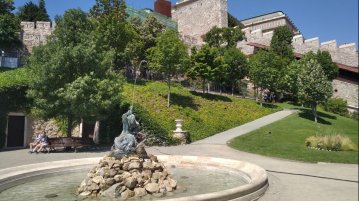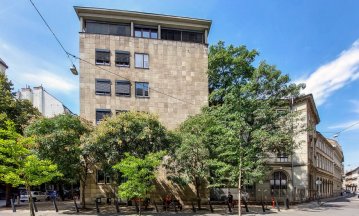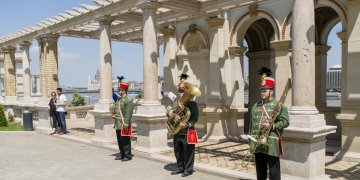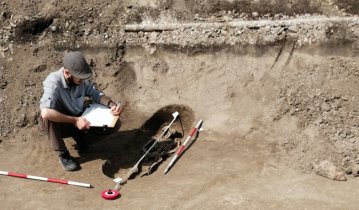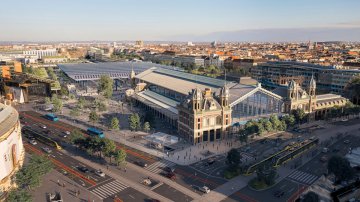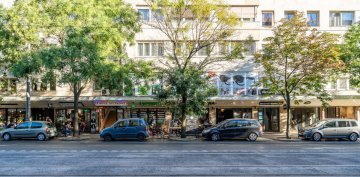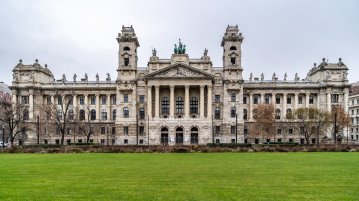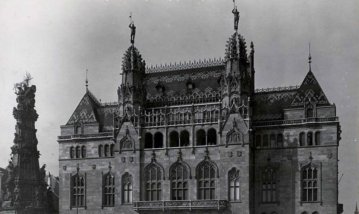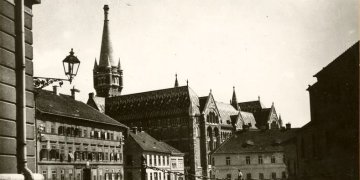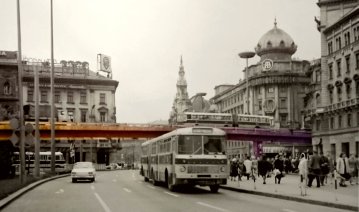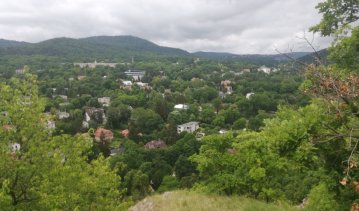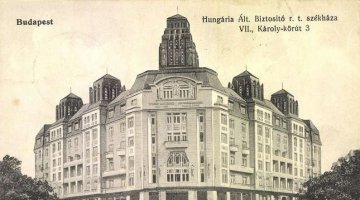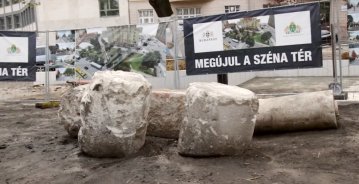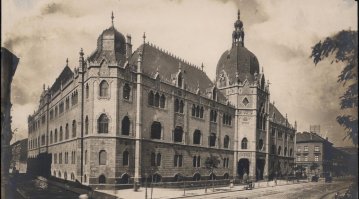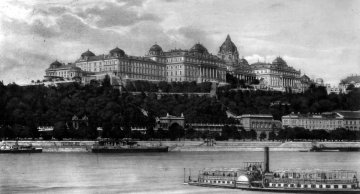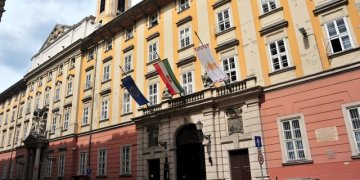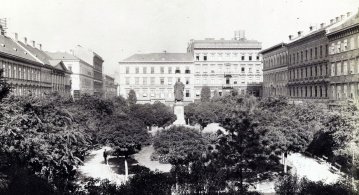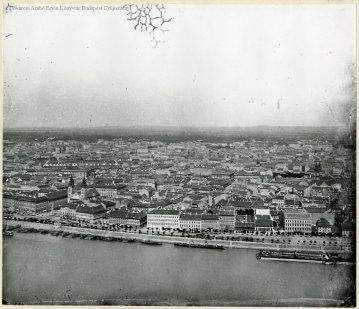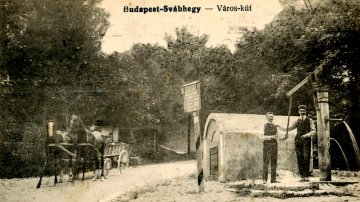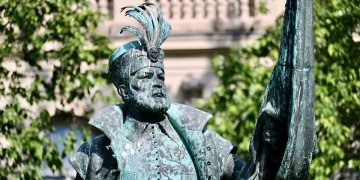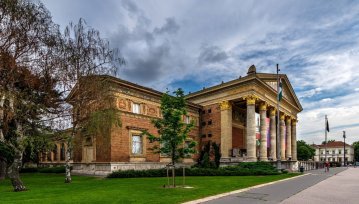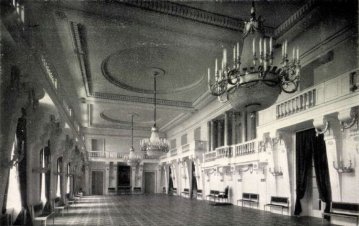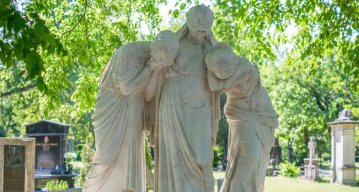 The Bridge Report, which brought a turning point in the history of Budapest
A travel report that changed the history of Pest and Buda, as well as Hungary. The little book contributed to the change of half a thousand years of legal customs and the implementation of an investment of unprecedented size and technical quality. This book was The Bridge Report [Hídjelentés in Hungarian].
The Bridge Report, which brought a turning point in the history of Budapest
A travel report that changed the history of Pest and Buda, as well as Hungary. The little book contributed to the change of half a thousand years of legal customs and the implementation of an investment of unprecedented size and technical quality. This book was The Bridge Report [Hídjelentés in Hungarian].
Search result
János Bobula designed the building of the 150-year-old secondary school in Pest
August 10, 2022 at 4:03 PM
150 years ago, in 1872, education began at the Secondary Training School of the Royal Hungarian Teacher Training Institute, i.e. today's ELTE Trefort Ágoston Secondary Training School. In the first 15 years of the institution, it did not yet have an independent building, they moved from one rental property to another. In the 1880s, the Minister of Religion and Public Education, Ágoston Trefort, commissioned János Bobula Sr. to design the school building that still stands today at the corner of Szentkirályi and Trefort Streets, which was handed over 135 years ago, in 1887.
Polish-Hungarian two good friends - the calvary of István Báthory's sculpture in Budapest
August 7, 2022 at 3:33 PM
The friendship between the Polish and Hungarian people goes back centuries, and it was founded by the kings ruling in the Middle Ages. One of the most important of them was István Báthory, who also acquired the Polish throne as a Transylvanian prince. His memory was cherished between the two world wars, and in 1933 - on the four hundredth anniversary of the monarch's birth - there were plans to erect a statue to him in Budapest, which was finally put in place only a quarter of a century later.
The plot of the demolished Burg Hotel was transferred to the property manager of the MNB
August 5, 2022 at 5:30 PM
The former Diplomatic House on Szentáromság square was demolished at the beginning of 2022, and a new conference center will be built in its place, the visual plans of which have already been presented. The plot was recently transferred to the property manager of the MNB.
Bridge inauguration: the renovated and expanded southern connecting railway bridge was handed over
August 4, 2022 at 5:30 PM
The first railway crossing was originally built in 1877 on the part next to today's Rákóczi bridge, the bridge has been rebuilt several times since then, expansion of its capacity was proposed as early as the 1910s, but it was only recently expanded to three tracks. The line is one of the country's most important east-west railway connections. 150 passenger and 100 freight trains cross the approximately 500-meter-long bridge every day, and 2.8 million passengers used it last year.
Plans for BME's new building on Goldmann square are awaited
August 3, 2022 at 2:00 PM
The public tender for the design of the new building of the University of Technology was announced. The call states as a separate clause that the Innovation and Development Center to be built on the site of the demolished Goldmann György square buildings of the BME must be worthy of the existing building complex on the Danube, which is part of the world heritage.
Brainstorming can start about Népliget - the capital has launched a design competition
August 2, 2022 at 7:00 PM
The Metropolitan council has issued a tender for the renewal of Népliget, design teams of which at least one member is a landscape architect can apply for the task. Based on the strategic plan adopted last year about Népliget, they have to formulate how they would imagine the future of Budapest's 130-hectare public park, protected since 2005.
Throughout the city, you can admire the statues of György Zala, who died 85 years ago
August 1, 2022 at 11:30 AM
György Zala owes the central sculpture group of the Millennium Monument on Hősök Square with the Archangel Gabriel to György Zala, as well as the original Andrássy and István Tisza statues in Kossuth Square, or the dignified seated statue of Queen Elizabeth in today's Döbrentei Square. Zala was one of the busiest sculptors of his time, and his legacy has an architectural aspect: his villa in Pest was designed by none other than the master of Art Nouveau, Ödön Lechner.
The Landerer printing house has become a historical monument
July 29, 2022 at 3:00 PM
Five new locations have been added to the list of historical monuments. Among them is the former Landerer printing house in the 5th District, where the 12 points formulating the demands of the 1848 revolution and the National Anthem were printed.
Interior transformation of the National Museum - The building was also expanded with a hidden floor
July 29, 2022 at 9:00 AM
The Hungarian National Museum is one of the iconic buildings of our country, so since it was handed over in 1847, attention has been paid to its condition. By the beginning of the 20th century, however, its collection had already grown to such an extent that excessive crowding made its operation impossible. Some of the preserved material was transported to other buildings, and then in 1926, its large-scale restoration began, during which a hidden, third floor was also created in 1927 - ninety-five years ago.
Where the Nyugat editors' favourite coffee house operated - The Krausz Palace was built on Sugárút
July 27, 2022 at 10:30 AM
The former Krausz Palace is located on 12 Andrássy Avenue, the capital's most representative road. Its designer, Zsigmond Quittner - the creator of the Gresham Palace - was only 27 years old when he designed this spectacular apartment building for the order of the wealthy manufacturer Lajos Krausz. Famous artists such as Károly Lotz, Gyula Donáth, and József Róna participated in the decoration of the house, built in 1885, whose works can be seen on the Opera House, Vigadó, and the National Bank building, among others. The Magyar Korona Coffee House later operated on the ground floor, which was also a favourite place for the editors and authors of the Nyugat.
Tamási Áron 125 – Exhibition opened on Andrássy road
July 25, 2022 at 7:00 PM
As part of the Áron Tamási commemoration year, the Hungarian Academy of Arts organized a fencing exhibition in honor of the great creator of Hungarian literature. The exhibition of 17 paintings related to the oeuvre of the writer, who was born 125 years ago, can be seen at 101 Andrássy road until October.
The glass hall of the Museum of Applied Arts is open again - you can see the never-before-seen art treasures of the Esterházy family
July 23, 2022 at 12:30 PM
The Museum of Applied Arts, which has been closed for renovations since 2017, has temporarily opened its doors. The glass hall and ground floor gallery of the building designed by Ödön Lechner and handed over in 1896 at the end of the millennium celebrations can be visited, where you can see a special selection of the war-damaged and never exhibited art treasures of the ducal treasury of Esterházy.
The last year of Pest's independence - Only 34 four-story houses stood in the city before unification
July 22, 2022 at 11:00 AM
Three small towns stood on the banks of the Danube 150 years ago. The largest of the settlements was Pest on the left bank, which already had almost 5,700 buildings. Budapest existed only in plans and legislation, but Pest was constantly being built and developed. In 1872, the last independent year before the unification of the city, 206 new residential buildings were handed over, but the fact that 28 stables were also built in the same year clearly shows the way of life and transport options of the time.
As of 1 August, four downtown public spaces will become state property
July 19, 2022 at 8:00 PM
From 1 August, Vörösmarty square , Széchenyi István square , Podmaniczky Frigyes square , and József Attila street will be owned by the state and managed by the 5th district local council. The law on this matter was adopted by the Parliament today.
The Nelson Mandela Park on Gellért Hill was handed over
July 19, 2022 at 12:00 PM
Although many people protested against it earlier, the Nelson Mandela Park was handed over on the northern slope of Gellért Hill, in the area between the Philosophers' Garden and Hegyalja street. The Capital City local council timed the handover to the 104th birthday of the first colored president of the Republic of South Africa.
The former youth camp in Csepel is being renovated
July 18, 2022 at 7:00 PM
A new family-friendly leisure park will be created on the banks of the Little Danube by the end of 2023 in the 21st district Holland street youth camp. A playground and pedestrian walkways will be built on the Csepel site, the existing boathouse will be renovated, and tennis courts will also be created. Demolition of the pavilion and dressing rooms, which were in poor condition, has begun.
A section of the wall of the Citadel, which is under renovation, has already been completed
July 18, 2022 at 5:30 PM
The nearly 10,000 square meter wall surface of the Citadel is being renovated, the first restored wall section can already be seen on the northern side of the rondella. The white limestones from Süttő and the carved red limestones from Tardos were covered with a special layer to make them durable. The completed wall section will soon be followed by the reconstruction of the entire Danube facade of the Citadel and then the Buda facade of the fortress.
Art inside the centuries-old walls - the little-known side of the University Church
July 17, 2022 at 9:00 AM
The walls of the University Church have been standing tall in the inner city of Pest for 280 years: the construction of one of the jewels of Hungarian Baroque architecture was finished in 1742, after nearly twenty years. However, this did not mean its completion, as the interior was still completely unadorned at that time. It got its worthy face surprisingly late, only in the middle of the 19th century, which was supplemented with additional details at the beginning of the 20th century- so the church we know today was formed then.
There will be a community garden in Szent István park
July 15, 2022 at 5:30 PM
In the 13th district's Szent István park, in the area between Pozsony road and Hollán Ernő street, the corner plots, which have been surrounded by low fences until now, will be turned into a community garden. The basketball court will also be renovated.
The renovation of the former Merlin Theater building begins
July 14, 2022 at 5:30 PM
The renovation of the former downtown transformer house in the courtyard of the City Hall, the former Merlin Theater building, will begin soon. After the works are completed next year, the building will reopen as a cultural and community space.
One of the most important plants of Hungarian industry was the Láng Machine Factory - a residential park is being built in its place
July 12, 2022 at 9:00 AM
The Láng Machine Factory, founded in 1868, was one of the most important factories in Hungarian industry. Its success can also be measured in the fact that in a relatively short time, the workshop of 8-10 people became a large company employing hundreds of employees. László Láng opened his workshop on Váczi Boulevard, today's Bajcsy-Zsilinszky Road, and then in 1873 he moved to Váci Road, where he operated until its cessation. There are only four buildings under monumental protection in the area of the former factory, around which a modern housing estate will soon be built.
The birth of an iconic place - Oktogon is 150 years old, which was called Nyolcszög Square for decades
July 10, 2022 at 12:30 PM
We can safely call Oktogon Budapest's most unique transport hub: with its regular octagon shape, it quickly stands out on the map, and its easy-to-remember name means refreshment for foreigners, especially in Hungarian conditions. In addition, public transport routes famous throughout Europe intersect here: the continent's first underground railway, as well as the busiest tram lines. Its birth also coincides with the beginning of the golden age of the capital: its current form was defined 150 years ago, and for a long time it was called Nyolcszög Square.
Surroundings of Buda Castle - The historic gardens are being renewed
July 9, 2022 at 9:00 AM
The National Hauszmann Program covers not only the reconstruction of the buildings of the Buda Palace District, but also the renovation of the gardens surrounding them. The royal environment at the turn of the century naturally also demanded eye-catching green surfaces, on which an army of gardeners worked. This wonderful environment survived the siege relatively unscathed, but the rebuilding after World War II did not spare it, so in fact these gardens can also be considered huge losers of deliberate destruction.
The building of the ELTE Faculty of Law on Kecskemét Street will be renovated - The Csekonics Palace once stood on the site
July 7, 2022 at 7:30 PM
Building B of the ELTE Faculty of Law is at 10–12 Kecskeméti Street, located at and connected to Magyar utca 31–33. The monument complex is now being renovated and modernized. A famous building once stood on the plot, the luxurious palace of the wealthy Csekonics.
Music plays in the most beautiful parts of Budapest
June 30, 2022 at 7:00 PM
160 mini-concerts are organized in the capital's historic squares in the summer. This year's Zenélő Budapest series will be held at venues such as the Museum of Fine Arts, the Hungarian National Museum, the Várkert Bazaar, the House of Hungarian Music or the Hegyvidéki Cultural Hall. This year, there will be events at the renewed historical locations of the Buda Palace District, such as the Csikós courtyard.
Archaeologists found an Árpád-era cemetery next to Budafoki road
June 30, 2022 at 4:00 PM
The excavations took place from April to June along the Budafoki road, north of the Kondorosi road, one of the surprises of the excavation was the discovery of an Árpád-era cemetery. Traces of the residential buildings of a settlement more than seven thousand years ago were also found in the area.
The free beach on the Római-part will open again this year
June 29, 2022 at 7:00 PM
From 15 July, you can swim again in the Danube, on the Római-part, Kossuth Lajos holiday beach 15-17. next to the Danube, in the Danube area. The free beach will be open until the end of August.
The development of Nyugati railway station won EU funds
June 29, 2022 at 4:00 PM
The National Transportation Center won 2.8 million euros, i.e. 1.1 billion HUF, in EU funds for planning the development of the Nyugati railway station. The development of the Southern Ring Road in the capital also received an excellent rating in the EU tender.
A new parking system is being introduced in Budapest
June 29, 2022 at 2:00 PM
The Capital City local council is introducing a new parking system consisting of four zone types, the area of paid zones is increasing, and parking fees are also rising. The new regulations will come into effect on 5 September.
Decorative painting on the walls was found in the renewed building of the Palace of Justice
June 28, 2022 at 2:00 PM
In 1949, the administration of justice was moved out of the Palace of Justice on Kossuth Square, opposite the Parliament, after which the building was divided into two parts, between which a wall was erected. The building is currently being restored, and in the process, original decorative painting was found in several places under the demolished walls.
French, Italian, German, Hungarian - The Royal Hungarian Ministry of Finance and its European counterparts
June 28, 2022 at 9:00 AM
Hungarian folk art played a major role in the magical interiors of the Szentháromság Square palace of the Hungarian Royal Ministry of Finance. Because at the time of its construction - at the very beginning of the 20th century - the national sentiment was on fire in our country, which was expressed in the language of architecture by reviving the people's ancient decorative motifs. A Ministry of Finance is an important institution in every country, but is the spirit of the given nation reflected on the walls elsewhere? By presenting some European examples, we are looking for the answer to whether this type of building was built based on this concept elsewhere.
The building of the National Archives is being reborn - There will be an observation deck in the new tower
June 27, 2022 at 5:00 PM
The renovation and expansion of the National Archives building in Bécsi kapu square will soon begin, and its iconic tower will be built again, where it will become a lookout point. A visitor and education center will also be created in the new building wing, and a garden and terrace will also be connected to the archive.
The archaeologists found a village in the city center from the 13th century, and the excavation is now continuing
June 25, 2022 at 3:00 PM
Archaeologists last worked 25 years ago in the courtyard of the downtown Károlyi Palace, under 16 Károlyi street, on the site of the home of the Petőfi Literary Museum. At that time, among other things, an 11th-12th century cemetery, 23 graves, a 13th century village and the stone cellar and food storage of a Turkish house were excavated. Excavations are now continuing again.
The dome of St. Stephen's Basilica went up in flames 75 years ago
June 23, 2022 at 11:30 AM
The construction of the largest church in Budapest took a very long time in accordance with its size, it filled the second half of the 19th century and even extended a little into the 20th century. It was finished in 1905, but forty years later a scaffolding was put up again: the damage caused by World War II had to be repaired. However, the renovation caused even more trouble, with an accidental fire burning the entire dome.
This could have been Budapest - New exhibition opened about the unrealised plans of the capital
June 21, 2022 at 7:00 PM
Everyone is equally interested in creating and maintaining good transportation. Many concepts have come to light in the nearly 150 years of Budapest, which wanted to help or add colour to our transport options: should there be a cable car that leads up to Gellért Hill? Should there be a footbridge on the Danube somewhere? Should the Hungária Ring Road be two-story? The exhibition, which opened on 21 June at the new location of the Museum of Transport, the Northern Maintenance Depot, will undertake to present the transport development visions that have not been realised but have been successfully reached the design table.
Hűvösvölgy, which is only cold in its name
June 18, 2022 at 11:30 AM
Most people associated Hűvösvölgy with the cold, but today it is less cool, especially in summer than in previous centuries. Moreover, the cool is refuted by a very interesting natural monument. It is a fairly large area, so it is worth visiting the Hűvösvölgy and its surroundings on two excursion days. The part of the city is also rich in natural, built and cultural sights, which already gained special importance in the time of King Matthias.
Abundance of towers and reliefs - This is what the well-known tenement house on Károly Boulevard looked like
June 16, 2022 at 1:00 PM
In the huge tenement house in the centre of Pest, at the intersection of Károly Boulevard and Dohány Street, renovation works will soon begin: it will get its characteristic towers that were demolished after World War II. It is a building that is especially important from the cityscape point of view, and in addition to the interesting roof elements, there are also large reliefs on it. The huge facade of the house is a very high-quality work from the beginning of the 20th century.
The columns of the old St. John's Hospital are on display in Széna Square
June 11, 2022 at 5:30 PM
Pieces of the column of the old St. John's Hospital, remains of a wall and a fragment of the support column of the statue of St. John of Nepomuk were found during the renovation in Széna Square. The relics will be exhibited in the renovated square.
World Art Nouveau Day is associated with Ödön Lechner
June 10, 2022 at 12:30 PM
We have been celebrating World Art Nouveau Day every year on 20 June, since 2013, at the initiative of Hungary. This day is associated with two famous architects of the turn of the century: Ödön Lechner (1914) and Antoni Gaudí (1926). The Museum of Applied Arts will be celebrated for two weeks, during which time it will present a number of Art Nouveau buildings in Budapest.
The builder of the royal palace was born 175 years ago - Alajos Hauszmann is remembered
June 10, 2022 at 10:00 AM
Alajos Hauszmann, who was born 175 years ago, is remembered on Thursday at the tomb in Fiumei road. He was the designer of the expansion and reconstruction of the Royal Mansion in Kossuth Square, the New York Palace, the main building of the Technical University, and the Royal Palace, but many public buildings, private houses and villas in Budapest were designed according to his plans. Through his work as a teacher, he had a significant influence on the Hungarian architecture and architects of the turn of the century.
The Budapest General Assembly has decided on new street names - From now on, there will be a Horn Gyula promenade
June 8, 2022 at 8:30 PM
Is it allowed to name a street in Budapest about a controversial politician? This was one of the most important issues at today's meeting of the City Assembly. Finally, the board voted to have the Horn Gyula promenade in the 13th district.
Construction work began in the Jókai Garden
June 8, 2022 at 3:00 PM
The Jókai Garden and the listed Steindl Villa will be renewed, and it will be a new nature exhibition place from next autumn. Construction work has already begun.
The end of the Salt Office in Pest - This is how József Nádor Square was born
June 7, 2022 at 11:00 AM
The Danube is still an important trade route to this day, but in the first half of the 19th century the navigable waterway was even more important. Among other things, salt was transported on it, for the storage of which and the administration of the related taxes, a Salt Office was erected on the banks of the Danube in Pest. South of it, in the building of the Thirtieth Office, customs duties for commercial goods could be handled. However, the development of the city forced their demolition, and the József Nádor Square was established in its place.
A plan made 150 years ago for the development of Pest - A special drawing of the Eskü Square Bridge
June 5, 2022 at 9:30 AM
150 years ago, there was no unified Budapest, but there was already a unified plan for the development of the future capital.
Wells, springs, baths in the 12th district: exhibition opened on the role of water in the Hegyvidék Local History Collection
June 3, 2022 at 8:00 AM
Already in the time of King Matthias, the Hegyvidék wells provided water to the Buda Castle, but Queen Elizabeth and Palatine Joseph also drank water coming from Svábhegy - revealed at the new exhibition on the relationship between Hegyvidék and the water, which opened on Wednesday in the building of the Hegyvidék Local History Collection next to the Horse Railway Cultural and Event Centre.
The chairlift will restart over the weekend
June 2, 2022 at 6:00 PM
From 4 June, the Zugliget chairlift will be open again, its one-month overhaul has been completed.
Gift of Franz Joseph - the statue of Miklós Zrínyi and Gábor Bethlen was inaugurated on Kodály Körönd 120 years ago
June 2, 2022 at 3:00 PM
King Franz Joseph decided 125 years ago to donate ten statues to the nation, and he himself would cover the costs of making public works of art that would depict the famous personalities of the Hungarians. The first two of these monuments were inaugurated 120 years ago on the Kodály Körönd, but today only the first of the statues of Miklós Zrínyi and Gábor Bethlen can be seen in its original location. On the occasion of the anniversary, we followed the fate of the statues of the Kodály Körönd in the last century.
Renovation of the Art Gallery may begin soon
May 30, 2022 at 11:30 AM
One of the wedges of Heroes' Square, the Art Gallery designed by Albert Schickedanz, will soon be renewed. The first phase of the renovation of the building, completed for the Millennium Exhibition in 1896, is the restoration of the façade, for which a heritage protection permit has recently been obtained.
The Hidden Treasure of Országház Street - A ceremonial hall with an adventurous story
May 29, 2022 at 9:00 AM
Walking in the Buda Castle, between the one- and two-storey houses of the narrow Országház Street, we would not even think that one of them hides a huge ceremonial hall. Although it is actually logical, as the name of the street already suggests that the greatest lords of the country once appeared here, and a representative hall was built for them. The life of the adventurous room took a turning point at the end of May 1929, as it was restored to its old glory after decades of neglect.
Masterpieces of tomb art on Fiumei Road - The graveyard that is known as a sculpture park
May 28, 2022 at 9:00 AM
The Fiumei Road Cemetery deserves special attention not only as a resting place for the country's greats, but also the sculptures and works of art belonging to the tombs are invaluable. From now on, visitors can use their phones to get to know them more thoroughly: they can read about the most outstanding sculptures and their creators with the help of a QR code.
 The Bridge Report, which brought a turning point in the history of Budapest
A travel report that changed the history of Pest and Buda, as well as Hungary. The little book contributed to the change of half a thousand years of legal customs and the implementation of an investment of unprecedented size and technical quality. This book was The Bridge Report [Hídjelentés in Hungarian].
The Bridge Report, which brought a turning point in the history of Budapest
A travel report that changed the history of Pest and Buda, as well as Hungary. The little book contributed to the change of half a thousand years of legal customs and the implementation of an investment of unprecedented size and technical quality. This book was The Bridge Report [Hídjelentés in Hungarian].
 Drama on the university wall - The heroic monument was planned 95 years ago
In the constant hustle and bustle of the Egyetem Square in Pest, the students may not even notice the monument that decorates the short section of wall between the church and the central building of ELTE. However, it commemorates their predecessors, the heroes who fought for their country in World War I, and those who heroically helped them. The first design of the dramatically collapsing soldier was born in 1928, ninety-five years ago.
Drama on the university wall - The heroic monument was planned 95 years ago
In the constant hustle and bustle of the Egyetem Square in Pest, the students may not even notice the monument that decorates the short section of wall between the church and the central building of ELTE. However, it commemorates their predecessors, the heroes who fought for their country in World War I, and those who heroically helped them. The first design of the dramatically collapsing soldier was born in 1928, ninety-five years ago.
 A message from the former school: An exhibition in memory of János Neumann was opened at the Fasori Secondary School
An exhibition was opened in János Neumann's former school, the Fasori Lutheran Secondary School, on the occasion of the 120th anniversary of the world-famous mathematician's birth. In the exhibition presenting the former Neumann milieu, paintings, graphics, photos, furniture, and objects tell the story of the art-supporting spirit of the noble bourgeois family at the turn of the century.
A message from the former school: An exhibition in memory of János Neumann was opened at the Fasori Secondary School
An exhibition was opened in János Neumann's former school, the Fasori Lutheran Secondary School, on the occasion of the 120th anniversary of the world-famous mathematician's birth. In the exhibition presenting the former Neumann milieu, paintings, graphics, photos, furniture, and objects tell the story of the art-supporting spirit of the noble bourgeois family at the turn of the century.

